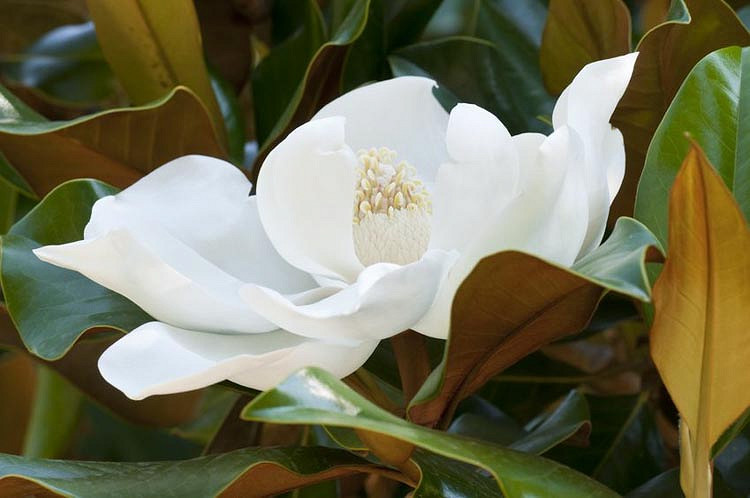Welcome to the enchanting world of the Southern Magnolia Tree (Magnolia grandiflora), an iconic symbol of grace and beauty in the Southern United States. This majestic evergreen has captivated hearts for generations. Originating from the southeastern region of North America, its glossy, leathery leaves and striking, large white blossoms exude a timeless charm that bewitches all who encounter it.
While its grandeur might lead you to believe it demands expert care, fear not! With a touch of patience and love, tending to this splendid magnolia can be a rewarding journey for both seasoned gardeners and enthusiastic beginners alike.
Common Magnolia Tree varieties:
- Southern magnolia
- Sweetbay magnolia
- Magnolia liliiflora
- Star magnolia
- Saucer Magnolia
Care
- Water: Everything starts with water. During the initial planting period, they require weekly watering to establish roots. Afterward, the watering frequency depends on soil drainage and regional rainfall to avoid leaf yellowing. Mulching is helpful, but ensure it doesn’t touch the tree trunk.
- Soil: These trees prefer moist, well-drained soil, and adapt well to various soil types and pH levels. They dislike extremely dry or waterlogged conditions and high alkalinity.
- Light: They thrive in partial shade, especially if the soil isn’t consistently moist. Once mature, they can handle full sun exposure if the soil is rich and moist. Receiving at least four hours of direct sunlight daily is ideal for blooming.
- Temperatures: Southern Magnolias flourish in temperate, humid, and semitropical climates, avoiding extreme temperature fluctuations. Even light frost can harm young seedlings.
Propagation
Propagating Southern Magnolia from cuttings can be tricky but feasible. Take a six-inch semi-hardwood cutting with leaves, apply rooting hormone, and plant it in a moist, well-drained medium. Be cautious with delicate roots during transplantation.
You can also grow these trees from seeds. Ensure you collect ripe cones and dry and soak the seeds in warm water to remove the coating. Sow fresh or refrigerate in a plastic bag with peat, vermiculite, or sand for two months. Germination may take up to 18 months. Move seedlings to a light shade, consider wintering in a cold frame or greenhouse.
Pruning
Pruning your Southern Magnolia – similar to Maple trees – is a great way to maintain its neatness and promote a dense shape. Best to wait until after the blooming season, but ensure you do it before winter, as dormant branches don’t heal well.
To encourage an open and natural form, avoid pruning the lower limbs, which also helps prevent stress-induced diseases and the formation of suckers.
Common pests
Frequently Asked Questions
This particular tree thrives in soil that is both moist and well-drained. It is also quite adaptable when it comes to varying levels of acidity.
Do Magnolia grandiflora lose their leaves?
Throughout the year, magnolias naturally shed their old leaves as part of their growth cycle. As the older leaves turn yellow, they gracefully fall to the ground. Observing closely, you’ll notice if new leaves are emerging to take their place, ensuring the magnolia remains vibrant and healthy. So, don’t worry when you see those yellow leaves, it’s just a natural process of renewal for these magnificent trees.
Why are my magnolia grandiflora leaves turning brown?
If you notice brown and dry leaf edges on your magnolia tree, it may be experiencing leaf scorch. This can happen when the temperature is high and there is low rainfall, causing the tree to lack sufficient water. This condition is similar to a sunburn for the leaves. To ensure your magnolia is hydrated, provide it with proper watering during hot and dry spells. This will help keep its foliage lush and vibrant.
How do you revive a dying magnolia tree?
Reviving a dying magnolia tree requires prompt and careful action. Here are some steps you can take to try and save it:
- Identify the Problem: First, assess the reasons behind the tree’s decline. It could be due to various factors such as lack of water, poor soil conditions, pests, diseases, or environmental stress.
- Watering: If the tree is suffering from drought stress, ensure it receives adequate water. Deeply water the tree, focusing on the root zone. Use a soaker hose or drip irrigation to allow water to penetrate deeply into the soil.
- Soil Improvement: Check the soil quality around the tree. If it’s compacted or lacks nutrients, consider aerating the soil and adding organic matter like compost to improve its health.
- Pruning: Remove dead and diseased branches carefully. This helps redirect the tree’s energy to healthier parts and prevents the spread of diseases.
- Pest and Disease Management: If pests or diseases are the issue, identify the problem and apply appropriate treatments, such as insecticides or fungicides, following the recommended guidelines.
- Mulching: Apply a layer of organic mulch around the base of the tree (but not touching the trunk) to retain moisture, regulate soil temperature, and suppress weed growth.
- Fertilization: If the tree is malnourished, consider using a balanced fertilizer to provide essential nutrients. However, avoid over-fertilization, as it can harm the tree further.


